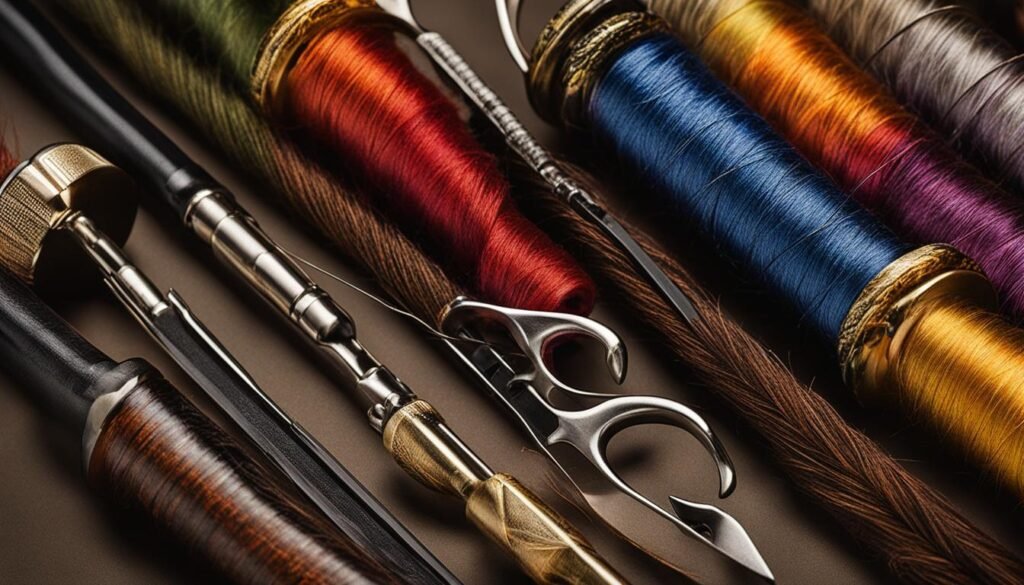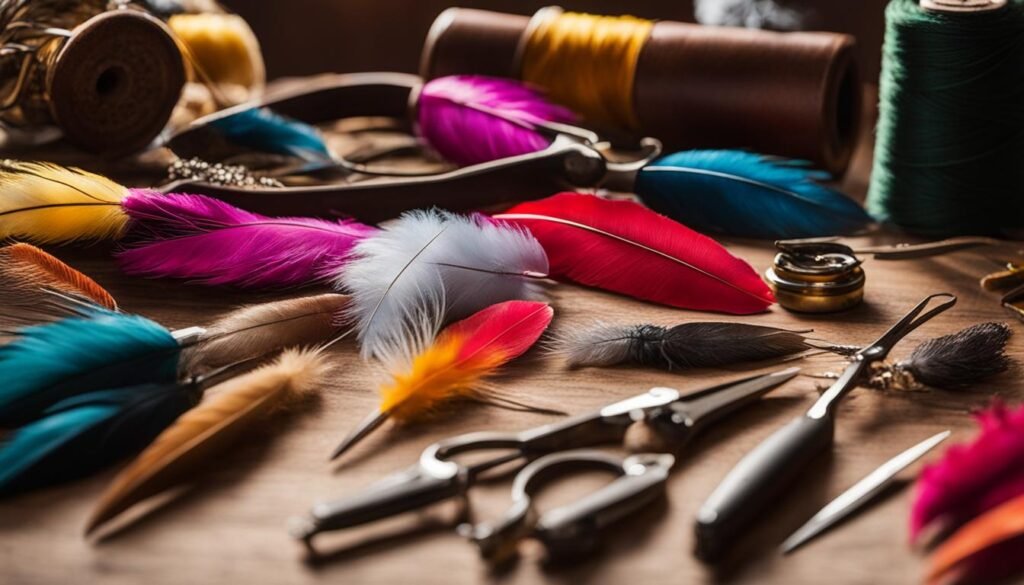As an avid angler myself, I understand the importance of having the right fly tying supplies for a successful fishing trip. That’s why I’m excited to share with you a comprehensive guide to top-quality fly tying supplies that will elevate your fly fishing experience.
Whether you’re a seasoned fly tying enthusiast or just starting out, having the right materials, tools, and kits can make all the difference in creating effective flies that attract fish. In this article, we’ll explore essential fly tying materials, must-have tools, convenient kits, and the allure of fly tying feathers, hooks, thread, beads, and dubbing.
With a wide range of high-quality supplies at your disposal, you’ll be able to create flies that perfectly mimic natural prey, increasing your chances of enticing a strike from even the most selective fish.
So, whether you’re looking to enhance your current fly tying setup or embark on a new fly tying adventure, join me as we explore the world of top-quality fly tying supplies together.
Essential Fly Tying Materials
When it comes to fly tying, anglers require a wide range of high-quality materials to bring their flies to life. These materials include feathers, hooks, threads, dubbing, and beads. Each component plays a crucial role in creating flies that are not only visually appealing but also effective in attracting fish.
Feathers are versatile materials used for wings, tails, and hackles. They provide lifelike movement and mimic the appearance of natural prey. Hooks and threads are the backbone of any fly, allowing anglers to construct the body and securely hold other materials in place. Dubbing materials add bulk and texture to imitate insect bodies or other prey, while beads offer weight and visual stimulation to sinking flies.
By having a diverse selection of top-quality materials, anglers can craft flies that perfectly mimic the characteristics of their target species. Whether it’s creating realistic mayfly imitations or flashy streamers, having the right materials is essential for success on the water.
Fly Tying Materials
| Material | Function | Examples |
|---|---|---|
| Feathers | Provide movement and mimicry | Hackles, marabou |
| Hooks | Construct the fly’s body | Dry fly hooks, nymph hooks, streamer hooks |
| Threads | Hold materials in place | Nylon threads, silk threads |
| Dubbing | Add bulk and texture | Natural fur dubbing, synthetic dubbing |
| Beads | Add weight and visual stimulation | Brass beads, tungsten beads |
With these essential fly tying materials at their disposal, anglers can create flies that closely resemble the natural prey found in their fishing waters. By understanding the role and function of each material, they can tailor their flies to match the specific characteristics of the target species.
Investing in high-quality fly tying materials not only enhances the angler’s creativity but also increases their chances of success on the water. So, whether you’re a beginner or a seasoned fly tier, make sure to stock up on these essential materials to take your fly tying game to the next level.
Must-Have Fly Tying Tools

Fly tying tools not only make the process easier and more efficient but also contribute to the overall quality and effectiveness of the flies being tied. Whether you’re a beginner or a seasoned angler, having these must-have tools in your arsenal will elevate your fly tying game.
1. Fly Tying Vise
A fly tying vise is the foundation of any fly tying setup. This tool holds the hook securely, allowing for precise and controlled tying. Look for a vise with adjustable jaws that can accommodate different hook sizes, ensuring versatility in your fly designs. Additionally, consider a rotary vise that allows for 360-degree rotation, making it easier to access all sides of the fly while tying.
2. Bobbins
Bobbins are essential for holding and applying thread to construct the fly’s body. Look for bobbins with adjustable tension, as this will enable you to control the thread’s tightness as you tie. Having multiple bobbins with different thread colors allows you to work on multiple flies simultaneously, increasing your efficiency and productivity.
3. Scissors
Precision is key when it comes to trimming and shaping your flies. Invest in a quality pair of fly tying scissors with fine, sharp blades. These scissors will allow you to make clean cuts, ensuring neat and professional-looking flies. Additionally, consider getting a pair of scissors with a serrated edge for added grip and control when working with certain materials.
4. Dubbing Twisters
Dubbing twisters are handy tools for spinning and distributing dubbing materials. They help create a uniform and well-blended body, giving your flies a realistic appearance. Look for dubbing twisters with a comfortable grip and a sturdy construction to ensure durability and ease of use.
5. Hackle Pliers
When it comes to adding hackle to your flies, having a good pair of hackle pliers is essential. These pliers provide a firm grip on feathers, making it easier to wrap them around the fly’s body. Look for hackle pliers with a smooth and adjustable grip to accommodate different feather sizes.
6. Whip Finisher
A whip finisher is a specialized tool used to secure and finish off the thread wraps on your flies. It creates a neat and durable knot, ensuring that the fly’s components stay in place during fishing. Look for a whip finisher with a comfortable handle and smooth rotation for precise knot tying.
Must-Have Fly Tying Tools
| Tool | Description |
|---|---|
| Fly Tying Vise | Holds the hook securely for precise tying |
| Bobbins | Holds and applies thread for constructing the fly’s body |
| Scissors | For trimming and shaping the flies |
| Dubbing Twisters | Spins and distributes dubbing materials |
| Hackle Pliers | Provides a firm grip on feathers for wrapping |
| Whip Finisher | Secures and finishes off thread wraps |
Convenient Fly Tying Kits
For aspiring fly tiers or anglers looking for convenience, fly tying kits offer a comprehensive solution. These kits provide a convenient way to access a variety of materials, tools, and instructions all in one package. Whether you’re a beginner or an experienced angler, fly tying kits can help you get started or expand your skills in fly tying.
One of the main advantages of fly tying kits is that they come with pre-selected materials. This means you don’t have to spend time researching and purchasing individual items separately. Instead, you can focus on honing your tying skills and experimenting with different patterns using the materials provided in the kit.
In addition to materials, fly tying kits typically include a set of essential tools. This ensures that you have everything you need to get started right away, without the hassle of purchasing tools individually. From vises and bobbins to scissors and dubbing twisters, these kits equip you with the necessary tools to tie flies effectively and efficiently.
| Benefits of Fly Tying Kits |
|---|
| Convenience: All-in-one package with materials and tools. |
| Cost-effective: Buying materials and tools individually can be more expensive. |
| Guidance: Kits often come with instructions and fly patterns to help beginners learn and improve. |
| Exploration: Opportunity to experiment with different materials and techniques. |
Whether you’re a beginner looking to explore the art of fly tying or an experienced angler seeking convenience, fly tying kits are a valuable resource. They offer a cost-effective way to acquire essential materials and tools while providing guidance through instructions and patterns. With a fly tying kit in hand, you can dive into the world of fly tying and unleash your creativity to craft flies that are bound to entice fish on your next angling adventure.
The Allure of Fly Tying Feathers
One of the key ingredients in creating effective flies is the use of high-quality fly tying feathers. Feathers not only add lifelike movement to flies but also enhance their attractiveness to fish. Whether you’re imitating emergent insects or mimicking small baitfish, the right feathers can make a significant difference in your fly patterns.
When it comes to selecting fly tying feathers, it’s essential to consider the type of feathers that best suit your desired fly designs. Hackles, for example, create a cushion-like effect on the water’s surface, imitating insects in their emerging stage. On the other hand, marabou feathers provide a flowing and pulsating motion that mimics the movement of small baitfish.
With fly tying feathers, you have a wide range of options in terms of colors and sizes. This versatility allows you to customize your flies to match the specific characteristics of your target species. Whether you’re targeting trout, bass, or any other species, having a diverse selection of feathers in your fly tying arsenal can greatly increase your chances of success on the water.
Feather Types for Fly Tying
| Feather Type | Characteristics | Common Use |
|---|---|---|
| Hackles | Stiff, long fibers; excellent for creating wings, tails, and hackles | Dry flies, emerger patterns |
| Marabou | Soft, flowing feathers; provide lifelike movement and bulk | Streamers, baitfish imitations |
| Pheasant Tail | Mottled fibers; mimic the appearance of various nymphs and insect bodies | Nymph patterns |
| Peacock Herl | Naturally iridescent fibers; create attractive bodies and thoraxes | Wet flies, nymphs |
The allure of fly tying feathers lies in their ability to add realism and allure to your flies. By carefully selecting and incorporating the right feathers into your patterns, you can create flies that not only look like the real thing but also perform exceptionally well in the water. So, the next time you tie a fly, remember the impact that fly tying feathers can have on your success as an angler.
Precision with Fly Tying Hooks and Thread

When it comes to fly tying, the selection of hooks and thread plays a crucial role in achieving precision and durability in your flies. Fly tying hooks come in various sizes and designs to cater to different fly patterns and fishing situations. Whether you’re tying dry flies, nymphs, or streamers, choosing the right hook ensures that your fly is properly balanced and mimics the natural prey. High-quality hooks provide the strength and durability needed to withstand the rigors of fishing, giving you the confidence to cast your flies without worrying about breakage or failure.
Fly tying thread, on the other hand, is used to secure materials and construct the body of the fly. It is essential to use strong and reliable thread that securely holds all the components together. The thread should be fine enough to create neat wraps and prevent bulkiness, yet strong enough to withstand tension and maintain the integrity of the fly. By using the right thread, you can ensure that your fly is properly built and able to withstand the strikes of even the most aggressive fish.
| Fly Tying Hooks | Fly Tying Thread |
|---|---|
| Dry Fly Hooks | Fine Thread |
| Nymph Hooks | Medium Thread |
| Streamer Hooks | Heavy Thread |
As shown in the table above, different fly patterns require specific types of hooks and thread. Dry fly hooks, which are designed for floating flies, are best paired with fine thread to create delicate and realistic flies. Nymph hooks, commonly used for subsurface patterns, call for medium thread that provides adequate strength to secure weight and materials. Streamer hooks, used for larger baitfish imitations, require heavy thread to handle the bulk and ensure durability.

